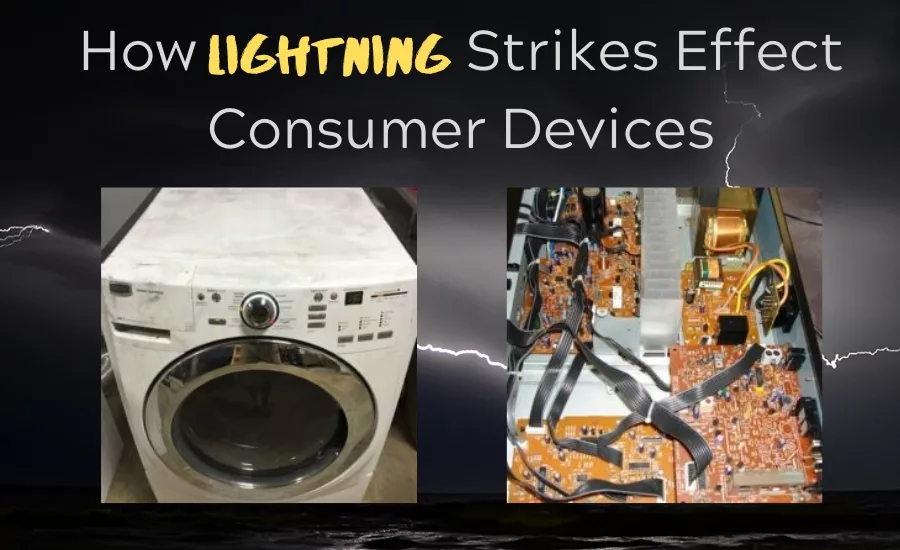How Lighting Strikes Affect Consumer Devices

Technology has become an integral part of people’s lives – from computers and phones, to TVs, large machines and equipment; these devices are the backbone of our modern society. But, as the consumption of electronics increases, so does our need to protect them from damage.
Damage from lightning is more common than we think. The Insurance Information Institute revealed that over $825 million was paid on more than 100,000 lightning claims annually. When a storm approaches, there are precautions one can take to protect their investment in electronics. Damage to equipment and devices comes from both direct and indirect lightning strikes.
Damage Caused by Direct Lightning Strikes
Most people see lightning danger as a bolt of electricity coming from the sky and directly striking a person or object. This type of lightning, called a direct strike, only accounts for 3-5% of all lightning-related injuries.
Related Reading
A direct lightning strike will cause significant damage to electrical and non-electrical devices. Direct strikes can cause notable structural damage, many times resulting in fires within walls or attic wiring. Typically, electronics that are plugged into an electrical system and impacted by a direct lightning strike cannot be protected by a surge protector for several reasons.
Firstly, lightning can create an electromagnetic pulse energy, causing damage to devices by generating over-voltage and power surges. These surges are very short-lived, momentary bursts of energy that drive tremendous amounts of current into an electrical circuit for a few millionths or a few thousandths of a second.
Additionally, semiconductors are extremely common in electronics and a lightning-induced surge will almost always exceed the voltage rating of these devices. This causes them to fail or alter the electrical characteristics so that they no longer function effectively.
Damage associated with over-voltage exposure increases with electronic technology advances because the components tend to become smaller. As the size is reduced, so is the microscopic spacing of insulators and circuits within the components which makes them more susceptible to over-voltage damage.
Since their transistors contain microscopically thin layers of glass that act as insulators, integrated circuits in computers are particularly sensitive to high voltages. The glass is so thin that it only takes a few tens of volts to cause a small spark to jump through the glass. When this happens, a small hole in the glass is created and allows the conductive layers on either side to make contact. Many other devices (such as diodes, transistors, etc.) contain extremely fine internal wires that connect the silicon components to the heavier exterior wires. A large surge of electric current can vaporize these thin wires the same way a fuse is blown.
Damage Caused by Indirect Lightning Strikes
Two of the most common indirect strike dangers include ground current, or step potential, and side flashes. Ground current/step potential occurs when lightning strikes the ground near a person or object. The current passes from the strike point, through the ground, and into that person or object.
Electronics and machinery are damaged. Energy from indirect lightning strikes enter the home through service wires like internet or cable TV lines, earth-ground wires or pipes that extend outside the home. The energy continues to travel through the electrical panel or reinforcement bars that are found in the foundation’s concrete. Damage from this type of event is generally less severe than that of a direct strike. However, when electronics are not properly connected to a point-of-use surge protector, serious damage can occur.
Evaluating How to Minimize the Impact of These Surges
Large appliances that utilize electronic controls are much more sensitive to surge damage from a lightning strike. Electronics that are properly connected to a quality surge protector can be safeguarded from voltage fluctuations.
The most challenging part when evaluating electronics impacted by lightning is that it can be extremely difficult to identify where all the damage has really occurred. Energy from a lightning strike can jump around or through components such as fuses, diodes, and others and wreak havoc on almost any part within the chassis of the device.
When lighting strikes, an electronic restoration company can perform a lightning strike validation to determine the cause of the outage and the best solution for damaged items. These validations include general vicinity assessment, device assessment, visual evaluation, functional tests, photo documentation, analysis and a final report with findings.
Likewise, when other types of disaster strike, such as water or fire damage, ERS can perform restoration of electronics and appliances (saving 62% on average versus replacement cost). Also in those situations, Art Recovery Technologies provides customers with the opportunity to salvage their art through restoration. The ART team of professionals understands the importance of fine art and are careful and deliberate in the handling of a damaged piece to ensure the correct, efficient, and cost-effective restoration of the item.
Looking for a reprint of this article?
From high-res PDFs to custom plaques, order your copy today!







